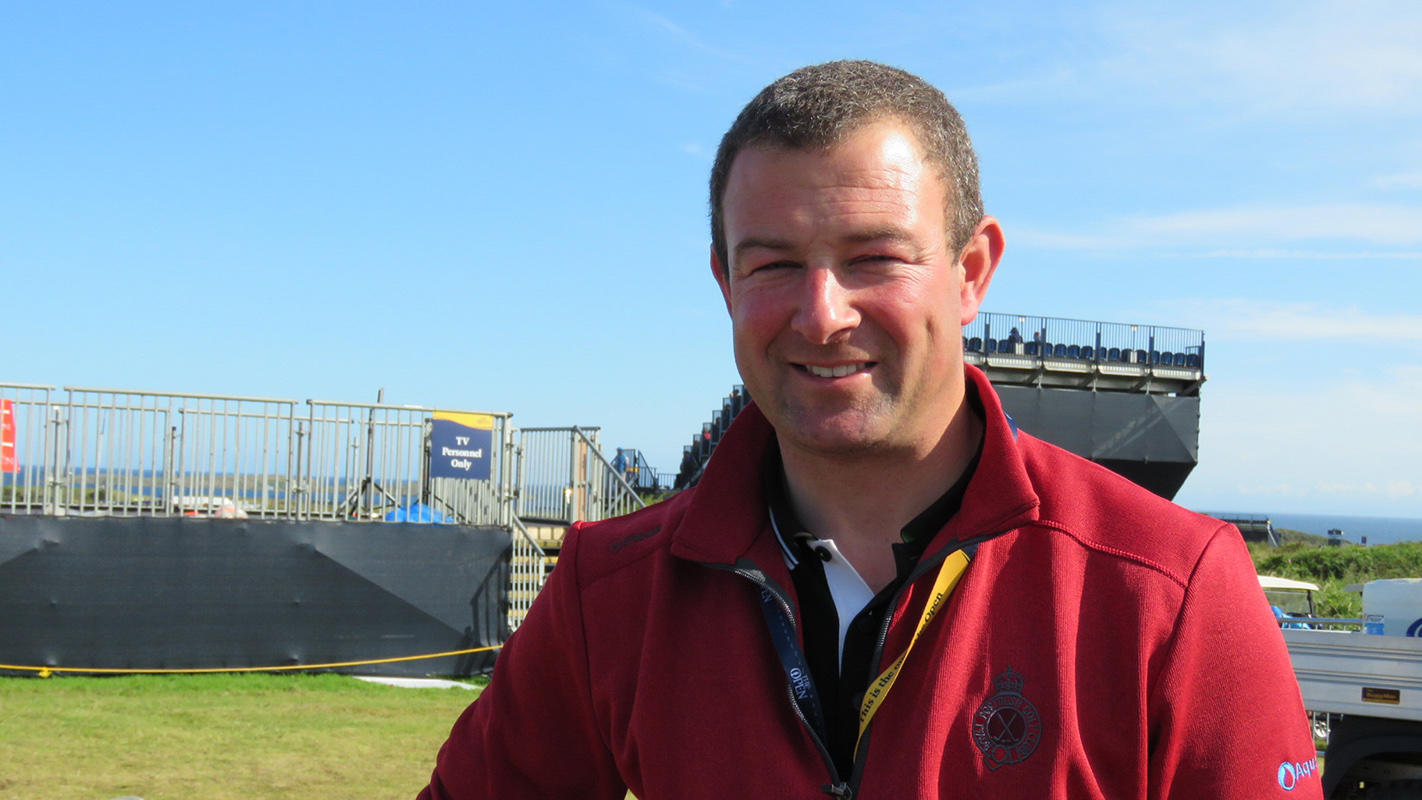- Homepage
- News and Features
- Talking green speeds and height of cut at the Open with Royal Portrush's Graeme Beatt
Talking green speeds and height of cut at the Open with Royal Portrush's Graeme Beatt

Early-morning hole changing on the Dunluce. Picture by Graeme Roberts
When Rory McIlroy hit that disastrous opening tee shot, effectively ending his Open weekend in a single stroke, little did he know that stood just a few feet from the unfortunate woman whose phone his wayward shot reportedly smashed, stood the man who had spent the past five years ensuring Royal Portrush would be in the best condition possible for the hometown hero to make Open history.
Rory’s day began (and pretty much ended) at 10.09am but for Graeme Beatt and his team, they were reporting for duty more than six hours earlier, at 4am.
“It’s a week where everyone here can be proud of themselves and all the work that’s gone in,” said Graeme, a softly-spoken 39-year-old St Andrews native. “All the heavy lifting was done in the last few years, so you could say that most of what we’ve done this past week is just a final polish.
“I would have been happier if we’d had a little less rain in the build-up and through the event, but at the same time the surfaces are firm and true. We’ve been mowing more regularly, each morning and night, whereas we wouldn’t have expected to do that.

Royal Portrush course manager Graeme Beatt
“Due to the rain there was extra moisture in the leaf of the grass, so everything became a bit slow and sticky and the run-offs were just a bit slow, so we started cutting them in the evening.
“The double cutting has been really useful and the smoothness has really improved since the first practice day.”
Throughout the opening three days of the championships, the greens have been cut at a height of 3.75mm. To put that into context, on each of the greens the team are only removing enough grass to fill a three-litre bottle. On the second cut there is barely any grass being clipped, but the additional process of grooming and rolling caused by running the mowers over the ground is enough to add two to three inches to the roll of the ball – the difference between a ball dropping into the hole or just coming up short.
As for the greens, they registered at 10.3 feet of roll on the second day of the championship and then a marginally-slower 10.2 feet on Saturday. Across all 18 holes, the difference between the greens is just a few inches. Graeme can expect his slowest green to be 10.1 feet and the fastest 10.4 feet. That’s elite level performance that’s only possible when you’ve got the incredible resources available to an Open venue.
“It’s hard to do that, but we have learnt how the greens will react to a cut,” explained Graeme. “Some of our newer greens will pick up pace more easily than some of the older greens. We know that one may be a simple cut and a stimp while another is a double cut. I suppose you could say the greens have their own personalities.”
Set up for the day’s play actually begins the previous afternoon, when Graeme will meet with the R&A to check out the weather report. The weather will determine what speed to set the greens at; high winds will dry out the greens and make them faster so they may want to cut less to counteract that. Rain will increase the moisture content and make the grass grow faster, so they may choose to trim then down. When that’s the difference between a ball skipping off a green into a run off area or a putt breaking a little sooner than a player may anticipate, such decisions can have a real impact on who takes the Claret Jug home at the end of the weekend
They’ve also got a catalogue of potential pin positions that has been gathered by the club over the years and R&A officials will be the ones to make that decision.
“We’ll agree what we’re going to do that evening and the following morning, then we’ll look at the tee times and decide how things are going to go the following morning.”

With course preparations complete, the 18th green is ready to witness history
The team arrives for duty and after a quick breakfast and coffee to wake up, they’re out mowing by 4.30am. The chipping and putting greens are first, before the 1stand 18thand then the remaining holes.
Whether mowing once or twice, the greenkeeping team must be finished and back in the maintenance facility prior to golfers arriving on the first tee at 6.30am. They can then put their feet up and relax or head out to enjoy the golf, while Graeme’s days are filled with meetings with the R&A and other official bodies. As play draws to a close in the evening, the team will head back out to prepare for the next day’s play, whether it be repairing divots or giving the course a mow.
It’s a fact that the Open wouldn’t be possible without a massive team of volunteers who give up their free time to get involved with the event, whether it be the BIGGA Volunteer Support Team who are tasked with tidying up the bunkers after a player has been in them or the volunteers who join the home greenkeeping team and take an active role in the preparation of the course. For example, did you know that the 18thgreen has been mowed this week by the course manager from Whitley Bay Golf Club on Tyneside?
It’s a massive, collaborative effort, but the one thing that’s shone through is how relaxed and enjoyable the entire experience has been for the team. With the Open returning to Northern Ireland for the first time since 1951 and this being the first major championship he’s ever prepared the course for, Graeme could be forgiven for being a little tense, but his calm demeanour has transferred to his team and they’re enjoying the whole experience.
“I didn’t feel relaxed the couple of days before the official practice day, with the number of little bits and pieces we needed to do. But as soon as we got into the event itself, I felt pretty comfortable,” said Graeme. “The key thing is to be prepared and then to not be tense. I’m getting feedback from the R&A and they’re relaxed, so that’s half the battle. If we’ve done our homework and our work before the championship begins, then we’re nearly there. The key is to prepare and have a really good team around you. Everyone has pulled it out of the bag and having a team you can rely on when it comes to the crunch is the most important thing.”
When it’s all over, the crowds will disperse and the players will go home. Some will have a sore head and one will have some additional hand luggage in the form of a famous trophy. But for the greenkeeping team, they’ll be right back at it on Monday morning, with a corporate event teeing off at 6am and a packed course as golfers jostle to play at the Open venue.
When will Graeme get the chance to reflect on his achievements? The coming weeks look busy, but perhaps it’ll be on the 18thgreen, shortly after the conclusion of play. The R&A has a tradition of inviting the greenkeeping team to form a guard of honour on the 18thgreen at the close of the tournament, where they welcome the winner on to the stage they have worked for years to prepare. As the eventual winner hoists the Claret Jug up high, there’ll be a group of 60 other unsung heroes soaking up the atmosphere and reflecting on their incredible achievements, each winners in their own right.
